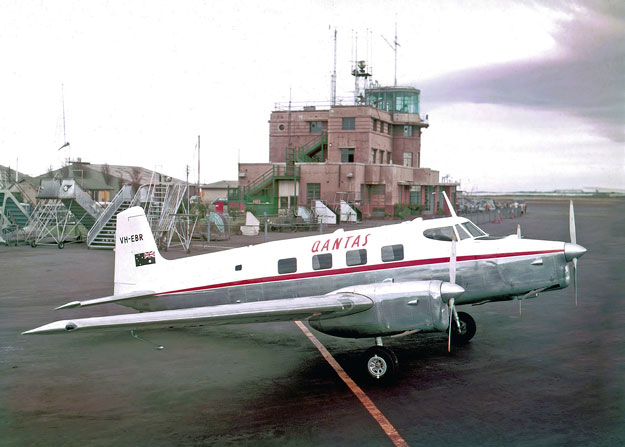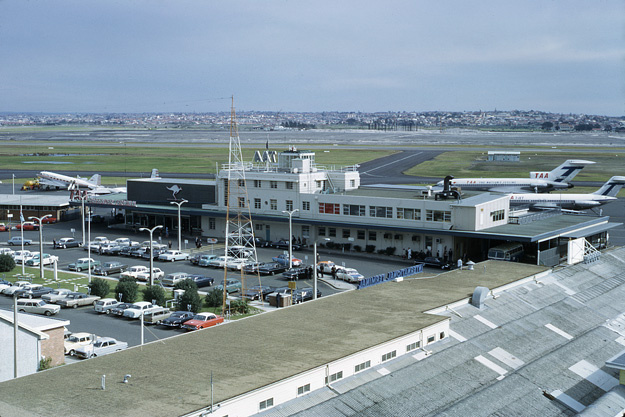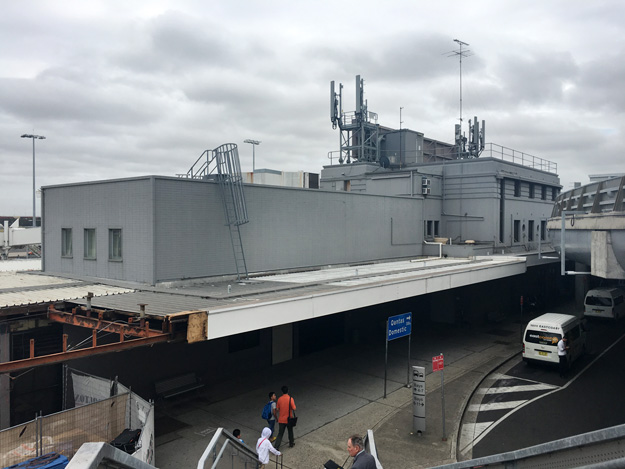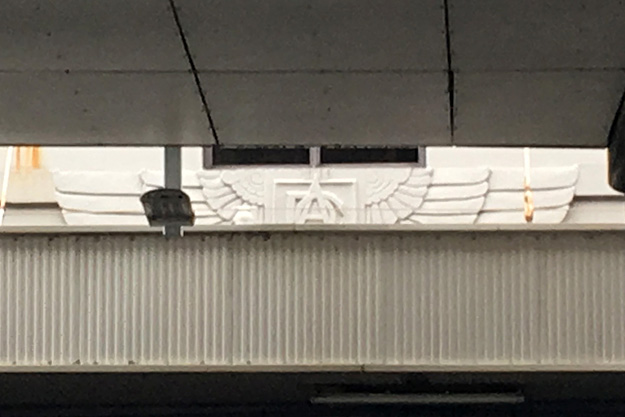
Behind Qantas
Empire Airways' Consolidated LB-30 Liberator G-AGKU the image above c.1945
can be seen the Control Building with the second Sydney/Mascot Control Tower perched on top. This art-deco building also housed the airport's passenger terminal. Nearly identical
Towers and Control Buildings were constructed at Brisbane/Archerfield
and Adelaide/Parafield, as well as Mascot,
in 1940. The building has been camouflaged as a precaution against possible
Japanese air raids.
This aircraft is the second of four LB-30s to serve with QEA. An unarmed version of the Liberator II, the LB-30s were ordered by the RAF in 1941 directly from the Consolidated production line rather than being diverted from USAAC production orders. It was designed specifically for British requirements and had no direct USAAC counterpart.
The RAF Liberator II/LB-30 differed from the previous Liberator I (which was basically a B-24A) primarily in having a three foot-longer nose section. Curtiss Electric propellers with long hubs replaced the Hamilton Standard propellers of other Liberator variants.
The LB-30s were initially operated by British Overseas Airways Corporation (BOAC) as part of the North Atlantic Return Ferry Service for RAF Ferry Command. In 1934, Q.A.N.T.A.S. Ltd and Britain's Imperial Airways Ltd had jointly formed Qantas Empire Airways Ltd to operate the Australia-Singapore section of the Australia-Britain air route. As the successor to Imperial Airways, BOAC inherited Imperial's 50% shareholding in QEA.
In 1944, QEA was desperately short of aircraft though impressments and war losses, and the British Air Ministry approved the transfer of two Liberators from BOAC to QEA for use on the Indian Ocean route. This was then being operated by five Catalinas which were flying the 3,513 nautical miles between Perth and Ceylon non-stop and in radio silence.
The first two Liberators, G-AGKT (RAF serial AL619) and G-AGKU (AL547) arrived in late 1944 and were flown to QEA's Brisbane/Archerfield workshops where they were modified with extra fuel tanks in the wings and seats for seven passengers in the bomb bay. The Liberators made a total of 259 crossings of the Indian Ocean.
A further two Liberators (G-AGTI and G-AGTJ) were subsequently delivered to Qantas in 1945/46. G-AGKU and G-AGKT were both scrapped in 1947, whilst in June of that year G-AGTI and G-AGTJ were put on the Australian register in QEAs 'Empire Airways' block as VH-EAI and VH-EAJ respectively. These two aircraft continued to serve with QEA until 1950, when they were both broken up for scrap.
The photo below, taken from a contemporary magazine, shows another view of the Control Building. This time the aircraft is Beech 18 HD776 of the Royal Navy's Fleet Air Arm. Toward the end of the Second World War a significant RN FAA presence developed in New South Wales in preparation for the planned invasion of Japan and a number of Beech 18s were operated as liaison aircraft.


The view at left shows the interior of the Tower cab atop the Control Building, sometime toward the end of the 1940s or early 1950s. Outside sit two of the new Convair 240s operated by Trans Australia Airlines (TAA). The Convairs were the first pressurised airliners in service in Australia and commenced operations in January 1949.
Below in this rare colour image, De Havilland Australia DHA-3 Drover VH-EBR waits outside the Mascot Control Building on 20 April 1951. It had entered service with Qantas Empire Airways (QEA) eleven days earlier. The aircraft was operated by QEA in New Guinea until the Drovers were withdrawn in 1954. It then went to Fiji Airways as VQ-FAO but crashed shortly afterwards due to an engine failure while switching fuel tanks.


Being the government's own airline, TAA occupied the original Mascot passenger terminal. Opposition ANA, later ANSETT-ANA, operated from their own premises further along. As the1960s progressed, the building was extended to increase capacity, as this photo above from August 1967 (with an enlarged view below) shows. The original Tower cab remained in place but a new Control Tower opened further to the south. In the distance, on the other side of the main north-south Runway 16/34 the beginnings of construction of the new International Terminal Building (ITB) can be seen.


Remarkably, the former Control Building still exists today, part of the domestic
terminal complex, but it has been so buried under other structures as
to be almost indiscernible. The image above gives a view from airside in 2011 while that below gives a landside view on 2 March 2018. At right is a raised roadway that virtually obscures the building completely to the casual viewer. However, if you look closely between the underside of the road and an obscuring facade, you can still see the original DCA 'wings' logo on the face of the building (bottom photo).


(Photos: 1,2-Geoff Goodall collection; 3,5,6-CAHS collection; 4-Ben Dannecker collection; 7-Grahame Higgs; 8,9-Phil Vabre)
Back to the main Air Traffic Services index
Back to the main Items of General Interest index
If this page appears without a menu bar at top and left, click here